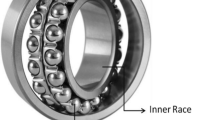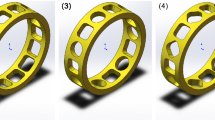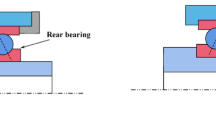Abstract
Misalignment is one of the most common causes of wear in bush bearings. Design improvements have been proposed by many researchers. Unfortunately, it did not efficiently reduce the misalignment. Classic geometrical designs sometimes reach their limits. For this reason, a bio-inspired design is proposed to solve the impediment. In this article, a bio-inspired bearing suited to misalignment was tested and compared to a classical bush bearing. The contact pressures of both bearings were compared with static Finite Element (FE) simulations for off-center load. Due to the complex shape of the involved contact, the performances of both bearings were also studied over time. Their wear behaviors were predicted with a numerical method. The methodologies emplaced to simulate the wear were described in this paper. Particularly, the wear coefficient determination obtained by experimental testing was detailed. The pressure value, the contact zone and the wear depth were compared and discussed. The wear results for the classical bearing are in accordance with the literature. The simulations show a deeper wear on the classical bush bearing than on the bio-inspired bearing. This leads to a longer period of service life for the bio-inspired bearing.
Similar content being viewed by others
References
Jang J Y, Khonsari M M. On the characteristics of misaligned journal bearings. Lubricants, 2015, 3, 27–53.
Marques F, Isaac F, Dourado N, Flores P. An enhanced formulation to model spatial revolute joints with radial and axial clearances. Mechanism and Machine Theory, 2017, 116, 123–144.
Cavalieri F J, Cardona A. Non-smooth model of a frictionless and dry three-dimensional revolute joint with clearance for multibody system dynamics. Mechanism and Machine Theory, 2018, 121, 335–354.
Colbert R S, Alvarez L A, Hamilton M A, Steffens J G, Ziegert J C, Burris D L, Sawyer W G. Edges, clearances, and wear: Little things that make big differences in bushing friction. Wear, 2010, 268, 41–19.
Strzelecki S. Operating characteristics of heavy loaded cylindrical journal bearing with variable axial profile. Materials Research, 2005, 8, 481–486.
Byrne G, Dimitrov D, Monostori L, Teti R, Van Houten F, Wertheim R. Biologicalisation: Biological transformation in manufacturing. CIRP Journal of Manufacturing Science and Technology, 2018, 21, 1–32.
Liu K, Jiang L. Bio-inspired design of multiscale structures for function integration. Nano Today, 2011, 6, 155–175.
Malshe A, Rajurkar K, Samant A, Hansen H N, Bapat S, Jiang W. Bio-inspired functional surfaces for advanced applications. CIRP Annals, 2013, 62, 607–628.
Porter M M, Ravikumar N, Barthelat F, Martini R. 3D-printing and mechanics of bio-inspired articulated and multi-material structures. Journal of the Mechanical Behavior of Biomedical Materials, 2017, 73, 114–126.
Vertechy R, Parenti-Castelli V, Menon C. Biologically Inspired Joints for Innovative Articulations Concepts. ESA: Bologna, Italy, 2005.
Porter M M, Novitskaya E, Castro-Ceseña A B, Meyers M A, McKittrick J. Highly deformable bones: unusual deformation mechanisms of seahorse armor. Acta biomaterialia, 2013, 9, 6763–6770.
Kim N H, Won D, Burris D, Holtkamp B, Gessel G R, Swanson P, Sawyer W G. Finite element analysis and experiments of metal/metal wear in oscillatory contacts. Wear, 2005, 258, 1787–1793.
Rezaei A, Van Paepegem W, De Baets P, Ost W, Degrieck J. Adaptive finite element simulation of wear evolution in radial sliding bearings. Wear, 2012, 296, 660–671.
Rezaei A, Van Paepegem W, De Baets P, Ost W, Degrieck J. Adaptive finite element simulation of wear evolution in radial sliding bearings. Wear, 2012, 296, 660–671.
Öqvist M. Numerical simulations of mild wear using updated geometry with different step size approaches. Wear, 2001, 249, 6–11.
Podra P, Andersson S. Simulating sliding wear with finite element method. Tribology International, 1999, 32, 71–81.
Mukras S, Kim N H, Sawyer W G, Jackson D B, Bergquist L W. Numerical integration schemes and parallel computation for wear prediction using finite element method. Wear, 2009, 266, 822–831.
Schmidt A A, Schmidt T, Grabherr O, Bartel D. Transient wear simulation based on three-dimensional finite element analysis for a dry running tilted shaft-bushing bearing. Wear, 2018, 408, 171–179.
Soubeyrand M, Assabah B, Bégin M, Laemmel E, Dos Santos A, Crézé M. Pronation and supination of the hand: Anatomy and biomechanics. Hand Surgery and Rehabilitation, 2017, 36, 2–11.
Poncery B, Arroyave-Tobón S, Picault E, Linares J M. Effects of realistic sheep elbow kinematics in inverse dynamic simulation. PloS One, 2019, 14, e0213100.
Picault E, Mermoz E, Thouveny T, Linares J M. Smart pressure distribution estimation in biological joints for mechanical bio-inspired design. CIRP Annals, 2018, 67, 153–156.
Sysaykeo D, Mermoz E, Thouveny T. Clearance and design optimization of bio-inspired bearings under off-center load. CIRP Annals, 2020, 69, 121–124.
Acknowledgment
This work was supported by Airbus Helicopters and Aix-Marseille University. The experimental devices were founded by: European Community, French Ministry of Research and Education and Aix-Marseille Conurbation Community.
Author information
Authors and Affiliations
Corresponding author
Rights and permissions
About this article
Cite this article
Sysaykeo, D., Linares, JM. & Mermoz, E. Wear Behavior of a Bio-inspired Bearing for off-center Loads. J Bionic Eng 17, 1251–1262 (2020). https://doi.org/10.1007/s42235-020-0107-3
Published:
Issue Date:
DOI: https://doi.org/10.1007/s42235-020-0107-3




